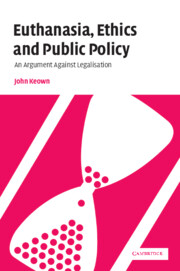Book contents
- Frontmatter
- Contents
- Preface
- Foreword
- Acknowledgments
- Table of cases
- List of abbreviations
- Introduction
- PART I Definitions
- PART II The ethical debate: human life, autonomy, legal hypocrisy, and the slippery slope
- 4 The value of human life
- 5 The value of autonomy
- 6 Legal hypocrisy?
- 7 The slippery slope arguments
- PART III The Dutch experience: controlling VAE? condoning NVAE?
- PART IV Australia and the United States
- PART V Expert opinion
- PART VI Passive euthanasia: withholding/withdrawing treatment and tube-feeding with intent to kill
- Conclusions
- Afterword
- Bibliography
- Index
5 - The value of autonomy
Published online by Cambridge University Press: 20 July 2009
- Frontmatter
- Contents
- Preface
- Foreword
- Acknowledgments
- Table of cases
- List of abbreviations
- Introduction
- PART I Definitions
- PART II The ethical debate: human life, autonomy, legal hypocrisy, and the slippery slope
- 4 The value of human life
- 5 The value of autonomy
- 6 Legal hypocrisy?
- 7 The slippery slope arguments
- PART III The Dutch experience: controlling VAE? condoning NVAE?
- PART IV Australia and the United States
- PART V Expert opinion
- PART VI Passive euthanasia: withholding/withdrawing treatment and tube-feeding with intent to kill
- Conclusions
- Afterword
- Bibliography
- Index
Summary
The ‘right to choose’
As we saw in chapter 4, the belief that in some circumstances death is better than life, that life is no longer worth living, is an important strand in the argument for VAE. Another strand, hardly less central, is that VAE respects a patient's right to autonomy or self-determination. The bulk of those campaigning for relaxation of the law weave the two strands together. They stress that they support only voluntary euthanasia: euthanasia is only ever justifiable at the request of the patient as no one but the patient is in a position to judge the worthwhileness of his own life. Only if the patient decides that life has lost its value and asks for VAE should it be performed.
Given the rise, particularly in the West, of an almost absolute respect for personal autonomy and the decline of established religious belief on which respect for the inviolability of life has traditionally been based, it is hardly surprising that support for VAE appears to have grown substantially. The traditional consensus has been undermined by liberal pluralism. Many people now reject traditional views about the inviolability of life – views which they often criticise as ‘religious’, ‘authoritarian’, ‘absolutist’ and unfairly ‘imposed’ by the law on non-believers. They support the relaxation of the law so as to allow individuals to make their own personal decisions about what to value and how to act, particularly when the decision affects so fundamental and personal a matter as when and how to die.
- Type
- Chapter
- Information
- Euthanasia, Ethics and Public PolicyAn Argument Against Legalisation, pp. 52 - 57Publisher: Cambridge University PressPrint publication year: 2002

